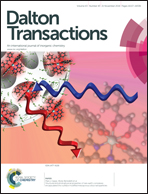On the coordination chemistry of organochalcogenolates RNMe2^E− and RNMe2^E^O− (E = S, Se) onto lead(ii) and lighter divalent tetrel elements†‡
Abstract
Several families of heteroleptic tetrelenes of general formulae M(E^RNMe2)[N(SiMe3)2] and M(O^E^RNMe2)[N(SiMe3)2] (where E = S, Se; M = Ge, Sn, Pb; RNMe2 = 2-(Me2NCH2)C6H4] supported by organochalcogenolato ligands have been prepared and fully characterised. The coordination chemistry of these ligands containing both hard (N, O) and soft (S, Se) atoms onto metals of varying size, polarisability, electropositivity and electrostatic surface potential has been explored. In the molecular solid-state, the complexes M(E^RNMe2)[N(SiMe3)2] are monomeric, although an occurrence of weak Pb⋯Se intermolecular interactions yielding a bimolecular species has been identified in the case of the plumbylene Pb[SeC6H4(CH2NMe2)-2][N(SiMe3)2]. On the other hand, all complexes M(O^E^RNMe2)[N(SiMe3)2] form centro-symmetric bimetallic dimers with O-bridging atoms. Multinuclear (29Si, 77Se, 119Sn, 207Pb) NMR spectroscopy and crystallographic studies reveal that the metal preferably remains 3-coordinated in all these heteroleptic complexes with absence of coordination of N and S/Se atoms, unless severe depletion of electronic density onto the metal is enforced. Coordination of these heteroelements can thus be achieved either through replacement of α-CH3 substituents (as in the ligand 2-(Me2NCH2)C6H4SeCH2C(Me)2O−) by electron-withdrawing α-CF3 moieties (as in the ligand 2-(Me2NCH2)C6H4SeCH2C(CF3)2O−), or else with recourse to the use of a cationizing agent leading to the formation of the ion pair [{2-(Me2NCH2)C6H4SeCH2C(Me)2O}Pb]+·[H2N{B(C6F5)3}2]− where the cationic metal complex is associated to a weakly-coordinating anion. The data collated herein provide compelling evidence that the coordination chemistry of divalent tetrel elements with ligands featuring both hard and soft donors cannot be reliably anticipated by sole use of general concepts such as the HSAB theory. The related metal complexes containing the rigid 8-(NMe2)naphthalen-1-yl group are also discussed.


 Please wait while we load your content...
Please wait while we load your content...